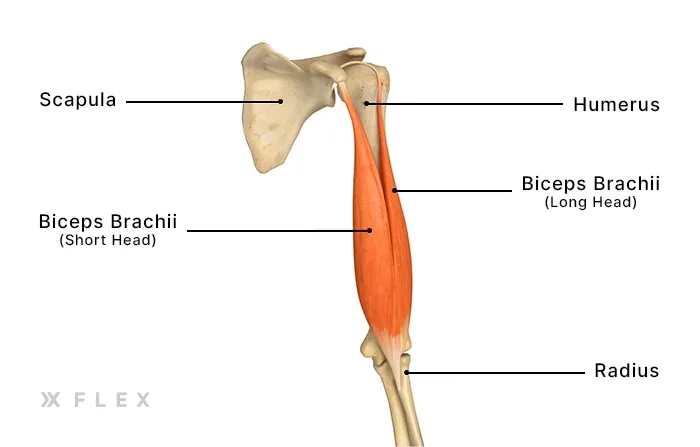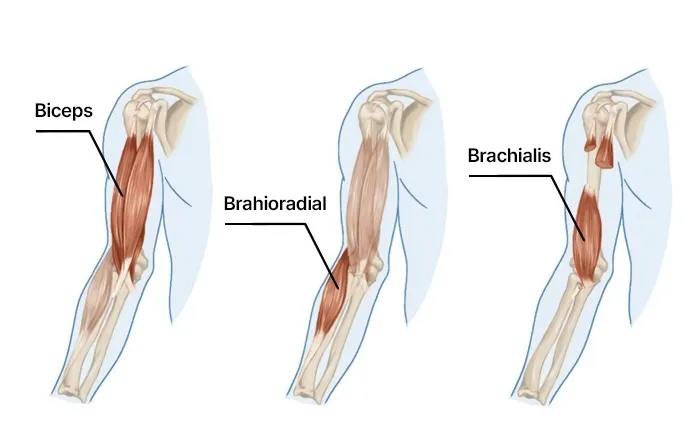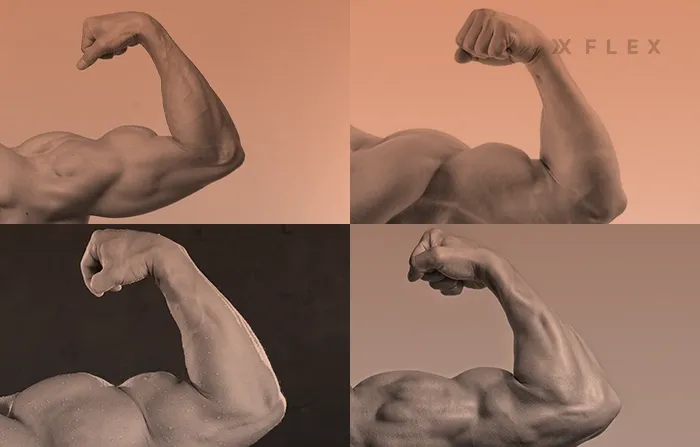Do You Have Bad Bicep Genetics? Try This Test
This guide will help you understand whether you have bad bicep genetics. Learn about bicep gaps and get targeted workouts for better biceps.
If Jeremy Allen White’s starring role in The Bear proved anything, it’s that the tight white T-shirt is the fit du jour. If you’re looking to show off a ripped upper body, this one's for you.
Bulging biceps are on the menu for 2025.
Let’s face it, work hard or don’t, some of us are blessed in that department. But what if no matter how many curls or pull-ups you cram into your gym routine, you’re not seeing any bicep improvement?
Are some of us just unable to grow great biceps?
If you feel like your parents cursed you with bad bicep genetics, it may not be all in your head.
Here, we’ll unpack the evidence that shows there’s a link between your genes and your potential for muscle development.
Plus, if genes aren’t working in your favor when it comes to bicep size, we’ll examine a few ways to target your biceps for hypertrophy and strength.
In fact, that’s exactly where the Flex AI app shines. We analyzes your training style and goals to help you build a customized plan, even if you weren’t blessed with perfect bicep genetics. From strategic volume to smart exercise selection, Flex makes every rep count.
Biceps Muscles

To start, let’s get to know a bit more about the biceps.
The biceps brachii is a large muscle on the inside of your upper arm. This is one of the key areas in strength training where people hope to get increased muscle mass.
This type of muscle is a “two-headed monster,” that is, it has a short head and a long head.
The biceps short head originates from the coracoid process of your scapula (the shoulder blade). The long head originates from the supraglenoid tubercle, also on your scapula.

The insertion point is the area where your muscle attaches to your bone. The biceps have two insertion areas: the radial tuberosity and the lacertus fibrosis (deep connective tissue on the inner part of your forearm).
Your body’s muscles are composed of a middle part called the muscle belly and tendons on either end. When you flex your muscles, the shape that you see that gets bigger is your muscle belly.
Because of its double-headed structure, the bicep has two tendons that attach to the shoulder and one at the elbow.
Is Bicep Shape Genetic?
Muscle shape, composition, and length are all strongly influenced by genetics.
What Are Bad Bicep Genetics?
While there are no formal “bad” vs. “good” definitions for bicep genes, there are some types of biceps that are considered more or less aesthetic in the bodybuilding world and fitness industry.
The length of your muscles, as we mentioned, is primarily determined by genes.
This can have a strong impact on how your muscles look. In fitness communities, certain shapes are considered more aesthetic.
Visually, bicep length mostly has to do with the ratio of tendon to muscle belly and the height of your muscle insertion points.
Now that we’re familiar with origin and insertion points, let’s see how they can influence the way your muscles look.

Short Biceps vs. Long Biceps

People are naturally born with longer or shorter biceps.
When we discuss short biceps, we mean biceps with a shorter muscle belly and longer tendons and insertions. This structure causes less volume in the middle of the biceps when you flex.
Long biceps, on the other hand, are biceps with longer muscle bellies and less length to the insertions and tendons. Since there is more muscle belly spaced along the length of your upper arm, it creates a fuller look all over, rather than concentrating the muscle fullness to one small area.
The length of your biceps muscles has nothing to do with your arm length, the width of your shoulders, or your height.
If you’re flexing, a short bicep can look better. You may see a higher apex to shorter muscles here which gives the “massive arms” look that most guys are looking for.
However, longer biceps may look larger in a rested state, since the muscles can look more evenly distributed. Although they may not look as full through the middle, the evenness of a long bicep generally gives them an aesthetic edge.
Bicep Insertion Points
Some people consider high bicep insertions “bad” since they attach closer to your shoulders. This creates more of a gap between the muscle and the elbow when you flex your bicep. We'll explore bicep gaps more later.
Biceps that have a high insertion point, where the muscle is attached higher on your arm closer to the shoulder can look shorter since the muscle belly won’t sit as close to your elbow.
Lower insertions, give your biceps a longer, more evenly distributed look.
A bicep with a lower insertion point on the shoulder can seem longer, since the muscle will descend further towards the elbow, creating less space.
Uneven Biceps
Most people also consider muscular imbalances to be a negative trait. Not only does this impact how you look, but how your arms work.
Your bicep has a “peak” when you flex. Usually, the peak of a muscle will sit in the middle of your muscle belly. On even biceps, you should see a single domed curve at the top of the muscle that tapers off evenly toward either end.
That being said, some biceps have the look of a divided peak: the bicep split.
Some lifters view it as an impressive, ultra-ripped look. But others don’t like it and prefer a smooth and cohesive look to their biceps.
The double peak is another genetic feature that can appear for some people but not be visible for others.

Sometimes you may also see an off-center peak. Flex your arm and see where the highest point of your bicep is. Does it fall right in the middle of your muscle? Maybe it sits up higher towards your shoulder or lower towards your elbow.
A muscular peak that is not dead-center can be genetic. It might not be the best-looking feature to some who prefer a balanced look.
Muscle Building Genes
On top of just the genetic factors that influence the shape and insertion points of your biceps, it’s important to consider the influence of genetic inheritance on building muscle overall.
Some people are more or less likely to be able to build muscle based on their genetics.
One gene in particular, ACTN3, has been linked to increased capability in athletic performance, commonly referred to as the “speed gene.”
This gene is linked to activation of the fast-twitch muscle fibers that work when you sprint or lift weights. Some people may be predisposed towards being either “endurance” or “power” athletes based on genetics. This gene works on the “power” side of things, so people with more active genes may have more capacity for generating power in their muscles.
Although this gene is still being studied, there’s some indication that it may help with muscle building as well.
What is the Bicep Gap?
Flex your arm, then consider the space between your bicep and your forearm. That’s what people are referring to when they mention the “bicep gap.”
Some people may have wider or narrower gaps, and some may have virtually no gap at all.
Try this test to see if you have long or short biceps:
How to Improve the Look of Your Biceps
Can you overcome the look of your biceps if you have bad bicep genetics?
Some traits you inherit and there's not much you can do about it, that being said, there’s always room for improvement.
To get better looks biceps, focus on:
Compound movements and lifts. Exercises like dumbbell or barbell curls can help you get stronger more sculpted biceps with an even balance throughout the muscles.
Exercises that activate your brachialis and brachioradialis muscles (elbow flexors) more efficiently may also be a good option for poorly developed biceps.

Some evidence suggests that using an EZ curl bar could put more emphasis on these muscles. Because they sit closer to the elbow, this may be a good option when looking to close your elbow-bicep gap.
Final Word
Bicep length is genetically determined and can not be changed through your workouts.
Having said that, it’s entirely possible to change the size and strength of your biceps through arm-focused workouts, a healthy diet, and adequate muscular recovery.
Although genetics predetermine many aspects of how your body looks and functions, there are always things you can do to optimize your genetics and work around them for better results.
For a quick test, bend your arm at the elbow joint in to a bicep curl. In this muscle contraction, as you're flexing the elbow, you can measure your bicep gap. If you can fit more than 2 fingers in the gap between your bicep and your elbow, you may have short biceps!
Although some find a short biceps brachii muscle less attractive, there are pros and cons to all bicep types. Short biceps vs. long biceps is a matter of preference. Being happy with the way your body looks and feels is what matters.
Don’t let your genes discourage you from training to be your best. There’s probably someone in the gym with “worse” bicep genes than you who trains more and is stronger as a result.
Letting genetics limit whether or not you work out your arms can just be self-defeating and cause you a lack of motivation in the gym.
How do I Improve My Physique With Bad Genetics?
If you love learning how to improve your physique, it can help you to set achievable targets and goals. A little inspiration can go a long way in getting you to your fitness targets.
Although it’s good to check in with your body and be aware of what’s going on, hyper-focusing on a body part that doesn’t “look perfect” will only stress you out and detract from your overall body goals.
Okay, maybe you have “bad biceps.” However, maybe you’ve got phenomenal calves, or you’ve got a perky round booty that just comes naturally. Perhaps it’s a heart-shaped butt that fills out a pair of gym shorts pretty nicely or your abs of steel have a sculpted V-line.
Or maybe you’re just one of the chosen ones who looks like a Greek God (minus the biceps).
Everyone’s got their strengths and weaknesses. Just because you lack in one area doesn’t mean you can’t make up for it in another.
Keep your workouts motivating and don’t get too lazy to work out. Understanding your body’s limitations can help you build the best physique possible for your potential.
Bad genes don’t have to mean bad workouts. Flex offers an all-in-one workout platform to help you learn new exercises, visualize your fitness journey and keep all your PRs in one place.
We’ve made it simple to work on customized fitness plans or to introduce a little friendly competition to your fitness community by sharing exercises with your friends. Try it for free through the Flex fitness app.
References
Boshnjaku, A., Krasniqi, E., Tschan, H., & Wessner, B. (2021). ACTN3 Genotypes and Their Relationship with Muscle Mass and Function of Kosovan Adults. International journal of environmental research and public health, 18(17), 9135. https://doi.org/10.3390/ijerph18179135
Krzysztofik, M., Wilk, M., Wojdała, G., & Gołaś, A. (2019). Maximizing Muscle Hypertrophy: A Systematic Review of Advanced Resistance Training Techniques and Methods. International journal of environmental research and public health, 16(24), 4897. https://doi.org/10.3390/ijerph16244897
Marcolin, G., Panizzolo, F. A., Petrone, N., Moro, T., Grigoletto, D., Piccolo, D., & Paoli, A. (2018). Differences in electromyographic activity of biceps brachii and brachioradialis while performing three variants of curl. PeerJ, 6, e5165. https://doi.org/10.7717/peerj.5165
Szewczyk, B., Paulsen, F., LaPrade, R. F., Borowski, A., Zielinska, N., & Olewnik, Ł. (2023). Anatomical variations of the biceps brachii insertion: a proposal for a new classification. Folia morphologica, 82(2), 359–367. https://doi.org/10.5603/FM.a2022.0022
Tiwana MS, Charlick M, Varacallo M. Anatomy, Shoulder and Upper Limb, Biceps Muscle. [Updated 2023 Aug 28]. In: StatPearls [Internet]. Treasure Island (FL): StatPearls Publishing; 2023 Jan-. Available from: https://www.ncbi.nlm.nih.gov/books/NBK519538/
Related articles


Get fit with Flex
Build muscle & lose weight fast for free.
Available on iPhone + Apple Watch





